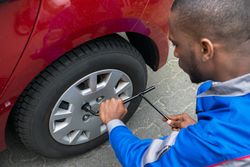How Often Do I Need to Rotate My Tires?

Tire rotation is an important but too-often forgotten part of auto care. During a rotation, your mechanic will move your tires onto a different place on the vehicle. They might also move the tire to a different axle or on the opposite side of the vehicle. The mechanics at Professional Automotive in Anchorage, AK, explain what you need to know about rotating your tires in the guide below.
When Should I Rotate My Tires?
Tires should be rotated every 5,000 to 7,500 miles. To remember this schedule, have the tires rotated every other time you get your oil changed. Since it can be difficult to keep track of every scheduled maintenance, keep a log that includes the date, mileage, and service details, like the mechanic’s name and business who worked on your vehicle.
Why Do I Need to Rotate My Tires?
 Over time, the rubber on your tires wears down. Depending on where the tire is positioned on your vehicle, wear will appear in different places and to different levels of severity. The outside of the tire usually deteriorates more quickly because of the weight distribution of your vehicle when you turn the steering wheel.
Over time, the rubber on your tires wears down. Depending on where the tire is positioned on your vehicle, wear will appear in different places and to different levels of severity. The outside of the tire usually deteriorates more quickly because of the weight distribution of your vehicle when you turn the steering wheel.
What Are the Benefits of a Tire Rotation?
When you rotate your tires, the wear will distribute evenly. This ultimately protects the rubber and extends the life span of your tires. You’ll also enjoy a smoother ride and better vehicle performance with stronger traction on the road. You might even find that your car gets better gas mileage after a rotation.
These benefits outweigh the small amount of time and money you spend on rotating your tires. When you take your car into Professional Automotive, you’ll have an ASE-certified mechanic working on your car. They service both foreign and domestic vehicles and have become the trusted automotive specialists of the community. Contact them at (907) 562-2471 to schedule an appointment for auto maintenance, or visit them online to learn more about their qualifications.
About the Business
(28 reviews)
Have a question? Ask the experts!
Send your question

